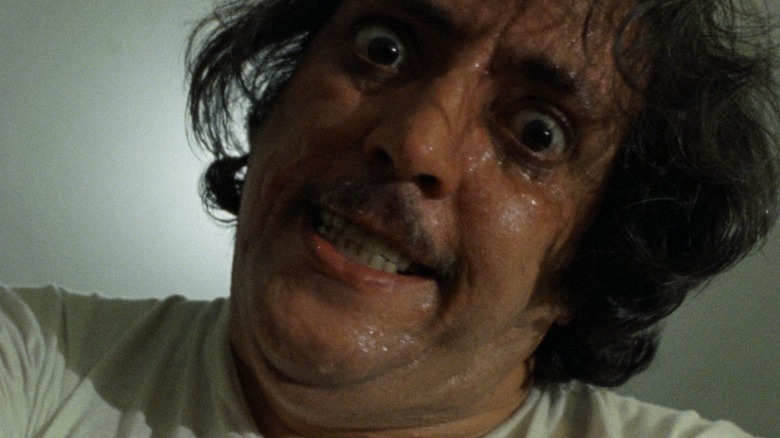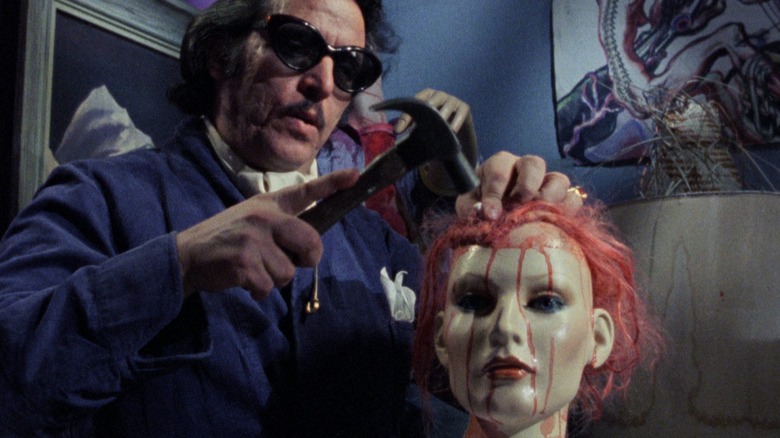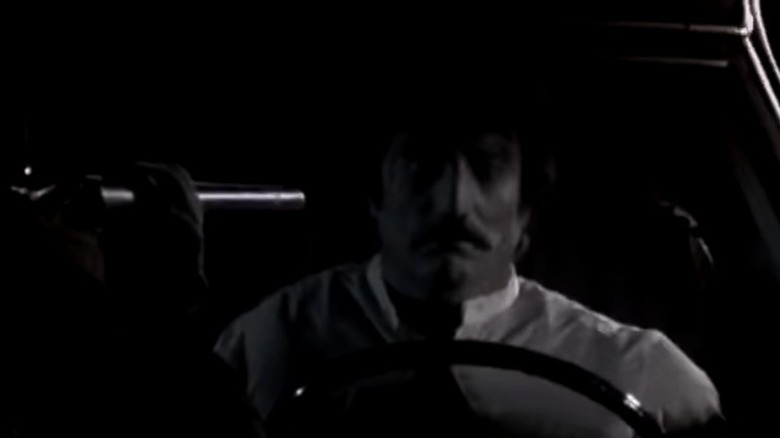Tom Savini Didn't Let The Law Get In The Way Of His Vision For Maniac
William Lustig's 1980 film "Maniac" is one of the sweatiest, most brutal, most unpleasant grindhouse horror films of its decade on either side. Co-screenwriter Joe Spinell plays Frank Zito, a serial killer with a peculiar M.O. When he encounters his victims, mostly young women, he declares them to be too beautiful, with beauty being punishable by death. He then strangles his victims, strips them, scalps them (!), and carries his "souvenirs" back to his cramped New York apartment where he dresses mannequins in the clothes and "wigs." The film's gore effects were provided by horror movie maestro Tom Savini, who had previously worked on notable horror classics like "Friday the 13th," and with George Romero on "Dawn of the Dead" and "Martin." Savini would also go on to direct the 1990 remake of "Night of the Living Dead."
"Maniac" is bleak and unpleasant, but may also serve as the Platonic ideal of an exploitation movie. Lustig and Spinell wanted to push horror into a space that felt unsafe, often making viewers question if the filmmakers themselves may be a little bent. The film caused a sensation when it was released, and both Gene Siskel and Roger Ebert walked out after 30 minutes. They both felt the film's violence to be so tasteless as to make the remainder of the film irredeemable.
Lustig's film was shot on a miniscule budget of $350,000, but was a hit making back $1 million. One might see a modern parallel in "Terrifier 2." It has since become a gore classic among horror fans, and often held in high esteem by fans of low-budget terror.
In 2018, when taking to Simon Abrams for RogerEbert.com, Savini talked about the film's bloody effects and how one scene in particular was technically illegal to shoot.
Disco Boy
In addition to providing the gore effects, Savini appeared in "Maniac" as a victim credited as "Disco Boy." In the film, Disco Boy and his girlfriend (played by Savini's actual ex-girlfriend), drive out to a dark, remote part of New York to have some privacy. The maniac waits nearby with a shotgun. Just as Disco Boy sits in the driver's seat to drive away, the killer emerges from the shadows, leaps up on the hood of the car, and shoots directly into the driver's head. Disco Boy's head explodes open, drenching his girlfriend with blood.
For that scene, the killer was also played by Savini. He recalls that firing a shotgun in New York was highly illegal at the time. Dangerously, he fired actual shotgun pellets into the face of a mannequin, constructed to look like Tom Savini himself and rigged to bleed. The filmmakers had to shoot fast — both the film and the gun — before fleeing the scene of the crime. In Savini's words:
"The couple is me and an ex-girlfriend; I actually did the firing. I shot both barrels of a shotgun with magnum pellets through the windshield. I mean, I've never fired a shotgun through a windshield before. I blew another point like that in 'Dawn of the Dead,' and I knew I could do it, but I never did it through a windshield. And when I fired the gun I flew backwards off the car."
Shotguns, it seems, possess quite a great deal of recoil when fired. Savini, unaccustomed to the weapon, had to be caught when the recoil threw him back. Odd to think Savini had to, in effect, shoot himself in the face to complete the scene.
Gun and run
After shooting his dummy, Savini recalls the whirlwind that immediately followed:
"Somebody caught me, and they immediately put me in a car and drove me away. The gun was given to some policeman and he drove it away. We stole that shot. You're not allowed to fire a gun in New York. There was nobody there sixty seconds after we did that effect."
It could be argued that "Maniac" is part of the New York No-Wave Cinema movement of the late '70s and early '80s, as it possesses the movement's DIY guerrilla attitude. Notable No Wave films include "Blank Generation," "Ms. 45," Susan Seidelman's "Smithereens," and Lizzie Borden's incredible "Born in Flames." Comparatively, "Maniac" was a grindhouse stepchild of the movement, alongside other local horror classics of the time like "Basket Case" and "The Driller Killer."
"Basket Case" and "Maniac" expanded into more gonzo territory than some of its peers, and would eventually be linked to horror luminaries like Herschell Gordon Lewis and autuers of his ilk.
These sorts of labels, though, are more fun to debate than definitive. Regardless of labels, "Maniac" is a harrowing, bloody, terrifying, disgusting, uncomfortable, sweaty, exhilarating experience for those seeking to delve into the trenches of low-budget sleaze. It's a classic for the ages.


